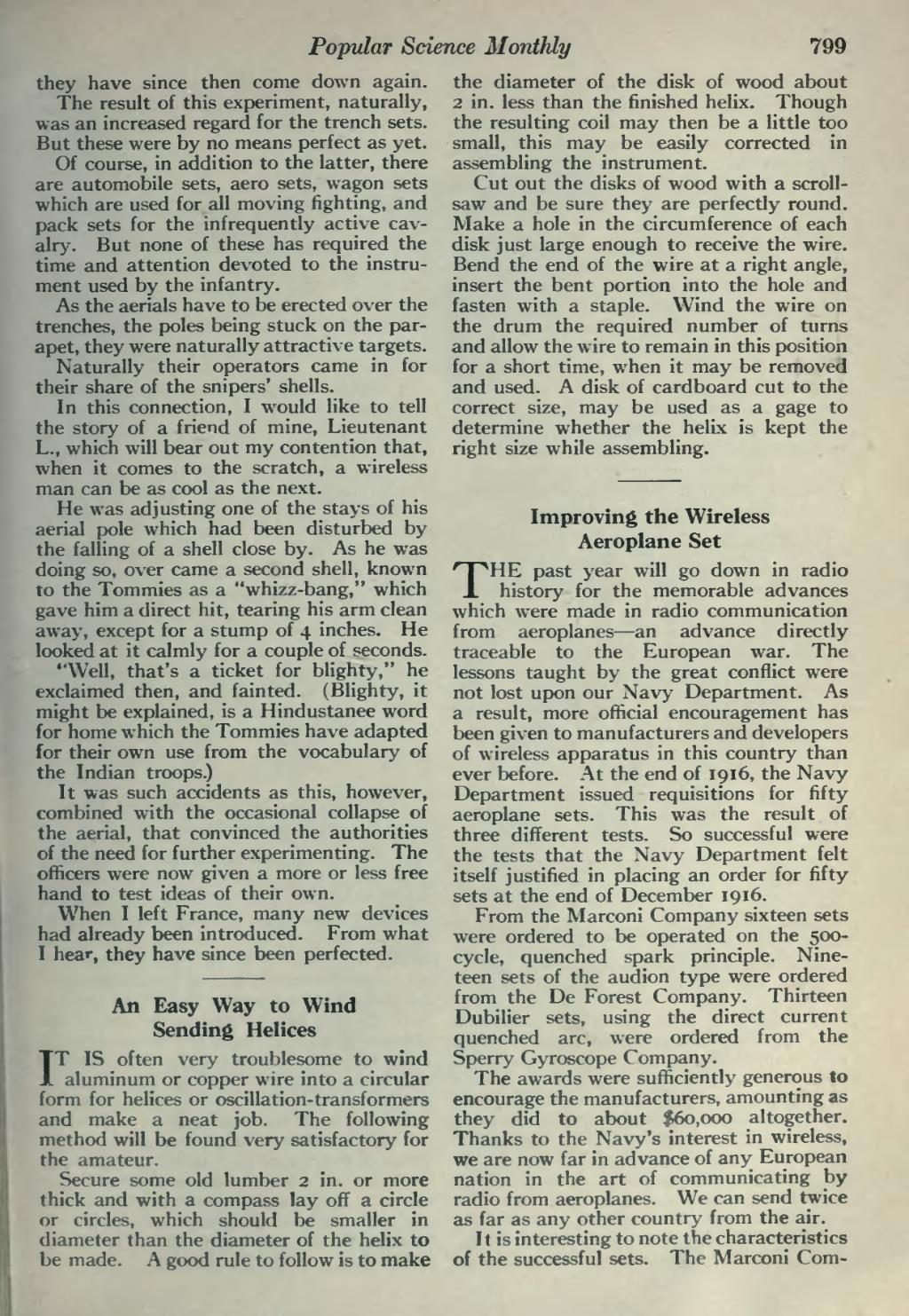Popular Science Monthly
��799
��they have since then come down again.
The result of this experiment, naturally, was an increased regard for the trench sets. But these were by no means perfect as yet.
Of course, in addition to the latter, there are automobile sets, aero sets, wagon sets which are used for all moving fighting, and pack sets for the infrequently active cav- alry. But none of these has required the time and attention devoted to the instru- ment used by the infantry.
As the aerials have to be erected over the trenches, the poles being stuck on the par- apet, they were naturally attractive targets.
Naturally their operators came in for their share of the snipers' shells.
In this connection, I would like to tell the story of a friend of mine, Lieutenant L., which will bear out my contention that, when it comes to the scratch, a wireless man can be as cool as the next.
He was adjusting one of the stays of his aerial pole which had been disturbed by the falling of a shell close by. As he was doing so, over came a second shell, known to the Tommies as a "whizz-bang," which gave him a direct hit, tearing his arm clean away, except for a stump of 4 inches. He looked at it calmly for a couple of seconds.
"Well, that's a ticket for blighty," he exclaimed then, and fainted. (Blighty, it might be explained, is a Hindustanee word for home which the Tommies have adapted for their own use from the vocabulary of the Indian troops.)
It was such accidents as this, however, combined with the occasional collapse of the aerial, that convinced the authorities of the need for further experimenting. The officers were now given a more or less free hand to test ideas of their own.
When I left France, many new devices had already been introduced. From what I hear, they have since been perfected.
��An Easy Way to Wind Sending Helices
IT IS often very troublesome to wind aluminum or copper wire into a circular form for helices or oscillation-transformers and make a neat job. The following method will be found very satisfactory for the amateur.
Secure some old lumber 2 in. or more thick and with a compass lay off a circle or circles, which should be smaller in diameter than the diameter of the helix to be made. A good rule to follow is to make
��the diameter of the disk of wood about 2 in. less than the finished helix. Though the resulting coil may then be a little too small, this may be easily corrected in assembling the instrument.
Cut out the disks of wood with a scroll- saw and be sure they are perfectly round. Make a hole in the circumference of each disk just large enough to receive the wire. Bend the end of the wire at a right angle, insert the bent portion into the hole and fasten with a staple. Wind the wire on the drum the required number of turns and allow the wire to remain in this position for a short time, when it may be removed and used. A disk of cardboard cut to the correct size, may be used as a gage to determine whether the helix is kept the right size while assembling.
��Improving the Wireless Aeroplane Set
THE past year will go down in radio history for the memorable advances which were made in radio communication from aeroplanes — an advance directly traceable to the European war. The lessons taught by the great conflict were not lost upon our Navy Department. As a result, more official encouragement has been given to manufacturers and developers of wireless apparatus in this country than ever before. At the end of 1916, the Navy Department issued requisitions for fifty aeroplane sets. This was the result of three different tests. So successful were the tests that the Navy Department felt itself justified in placing an order for fifty sets at the end of December 1916.
From the Marconi Company sixteen sets were ordered to be operated on the 500- cycle, quenched spark principle. Nine- teen sets of the audion type were ordered from the De Forest Company. Thirteen Dubilier sets, using the direct current quenched arc, were ordered from the Sperry Gyroscope Company.
The awards were sufficiently generous to encourage the manufacturers, amounting as they did to about $60,000 altogether. Thanks to the Navy's interest in wireless, we are now far in advance of any European nation in the art of communicating by radio from aeroplanes. We can send twice as far as any other country from the air.
It is interesting to note the characteristics of the successful sets. The Marconi Com-
�� �
